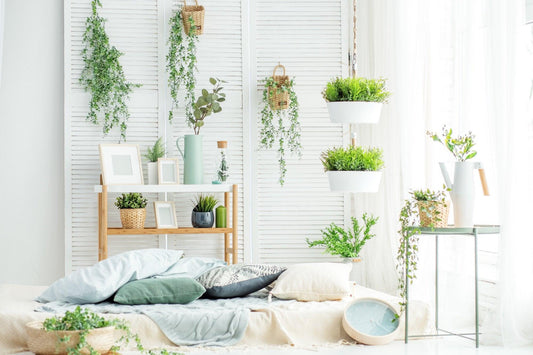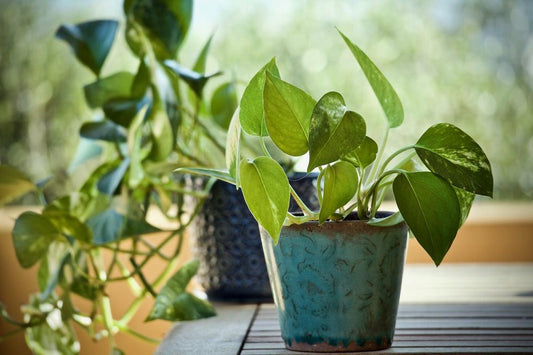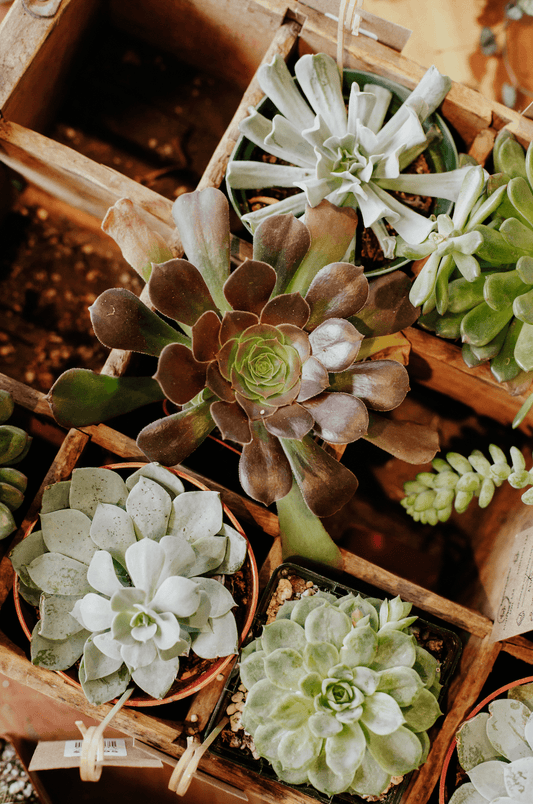What are the basics of plant care?
The essentials of plant care are to get to know your individual plant's needs, and to pay attention to how they react to their environment and care. Plants will thrive when they are provided conditions that are similar to their native habitats. This is why desert plants enjoy bright light, and rainforest plants fare better in dappled, indirect light. Each plant will have it's own needs for light exposure, frequency of watering, and presence of humidity, so get to know what your plant needs and provide for those needs as best you can! The next step is being aware of any changes in the plant. If it's getting too much light, the leaves will start to burn. If it's not getting enough light, the lower leaves might fall off making the plant look 'leggy.' Underwatering might cause the leaves to pucker, and your plant is being overwatered if there is standing water in the saucer. The more you get to know your plant, the clearer these signs will become!
A couple of other helpful tips:
Avoid too much environmental stress. Don't put your plant too close to a heater or a drafty spot, and try and provide a stable environment whatever that is.
When you repot, choose a container that is no more than 2 inches than the current container.
It's better to underwater than overwater your plant. Very few plants are content to sit in soggy soil.
Which plants are great for beginners?
The absolute best plant for a beginner is the ZZ plant, which you may have heard is indestructible. This is an extremely hardy plant that is drought and shade tolerant, and the only thing that it won't like is direct sun. If you are new to taking care of plants, or know that you are a forgetful plant owner, this is a great plant for you. Similarly sturdy is the sansevieria, and we have some beautiful varieties in the shop! Sansevierias do well with less attention, less watering, and lower light conditions. If you want a low-maintenance plant that's a bit leafier, Spider plants and Pothos do well in most conditions and are very forgiving while you figure out how to take care of them!
Which plants do well in low light?
It's fun to imagine a plant's native environment in order to answer this question. For example, in our shop we have a handful of plants that naturally grow in the understory of a rainforest. These plants are happy in partial shade or dappled light because their natural habitats would involve partial obstruction of the sun by other plants in the vicinity. Our most shade-tolerant plants include Snake plants, Ivy, Peperomia's, some varieties of Pothos (those types with more white variegation on their leaves want a bit more light), ZZ plants, Parlor Palms, Maranta's, and some varieties of fern.
Which plants are pet friendly?
When we say pet friendly, we mean that if your pet (often cat) nibbles on your plant, they won't have any adverse effects which could range from mild stomach upset to something more painful. We mark plants as pet friendly if they have been rated that way by the ASPCA. In our shop, you'll find the most pet friendly plants over by the Calatheas, Peperomias, and Air plants (Tillandsia). Many succulents are also pet friendly, but notably not Jades, Aloes, Euphorbias, Kalanchoes, or members of the Senecio family (String of Pearls, String of Dolphins, String of Bananas, Red Necklace, String of Turtles). Cactus are not toxic if consumed, but we recommend keeping them out of reach of your pets so they don't get poked by the spines.
Which plants do well in bright light?
Following the same logic as we do with shade-tolerant plants, our bright light plants would have access to much more light in their natural environments so they'll want higher light conditions when you bring them indoors. Cacti, succulents, Lavender, Catnip, and Ponytail Palms will all enjoy a little extra light. With your succulents under bright light, you might notice that they start to develop pinkish red hues which is a natural response to the environmental pressure of more light.
For those plants that like a lot of sun, they will be happy placed near West or South facing windows. If a tag says that your plant wants bright, filtered light, the intensity of afternoon sun may be too bright, but sheer curtains can provide that dappled light that many plants are looking for. East-facing windows offer mellower morning light. North-facing windows offer the least amount of light, so you'll want to look for plants that have lower light requirements to fill those spaces.
How do I repot a plant?
First, check to see if it needs repotting. If there are roots popping up around the edges of the topsoil, or you see some poking through the drainage holes at the bottom of the pot, this is a sign that your plan needs some extra growing space. There are a few exceptions to this rule as some plants, Umbrella trees for example, like to be root bound.
1) Once you have determined that your plant needs to be repotted, get a pot that is no more than 2 inches wider in diameter than it's current pot.
2) Fill the new pot about a third of the way with new soil. When we repot in the store, we use a little sheet of aluminum mesh on top of the drainage hole to prevent soil spillage.
3) Hold onto the base of your plant with one hand, and gently squeeze the old pot with the other hand until your plant slides out. If there are roots growing out of the drainage holes, you may want to cut the container rather than trying to pull the roots through.
4) Gently massage the base and roots to shake off as much old soil as possible.
5) Place your plant in the center of the new pot (you want the root ball of the plant to be an inch or so below the rim of the new pot).
6) Fill around the plant with soil, covering the root ball at the top, and gently patting the soil down with your fingertips.
7) Water your plant in its new home. We like to use water with a bit of Yucca extract (we sell this in the store) as it helps the plant adapt to the stress of repotting.
What do I do about bugs? How can I prevent pests?
The first thing to do to prevent pests is to make sure that your plant is healthy and in proper conditions for maintained health. Similar to our immune systems, plants are more susceptible to intruders when they are not getting the care they need.
If you notice a pest on your plant, it's important to act quickly. Isolate the plant from other healthy plants (and check to make sure the pests haven't already spread). Sometimes you can smush or gently rinse off bugs. Trim and throw away badly infested parts of the plant (and sanitize trimmers before touching any healthy growth!) Insecticidal soap and neem oil are popular treatments for pest problems, and you can treat your plant with these until the infestation is eradicated. When it comes to harsher substances like rubbing alcohol, know that some plants can take a full dousing (like sansevierias) and other plants may be more sensitive. Do your research before spraying your plant down with a harsh substance.
We recommend (and sell) two products to prevent pest problems: Beauveria bassiana and PureCrop1. Beauveria bassiana is a naturally occurring fungus that acts as a parasite to infect and kill bugs. PureCrop1 functions as an insecticide, fungicide, biostimulant, and surfactant. It works to stop pest infections, and helps increase the sugar content of the plant which in effect strengthens its immune system and makes it more capable of responding to threats.
What do you have going on with your soil?
We get our soil from a local provider in Golden, and we love it! When it comes to plant health, we'll tell you that "a plant's life begins in the dirt" and it's important that the dirt is nutrient rich and supportive for the plant to thrive. Our organic soil contains coco coir, peat moss, pumice, humus, earthworm castings, bat guano, glacial rock dust, volcanic ash, fish bone mea, oyster shell, seaweed, yucca, neem seed, alfalfa, mycorrhizae, and crab meal. These ingredients work together to make a powerhouse soil that provides your plant with nutrients to thrive.




